Honey Bees May Soon Take Probiotics to Improve Their Health
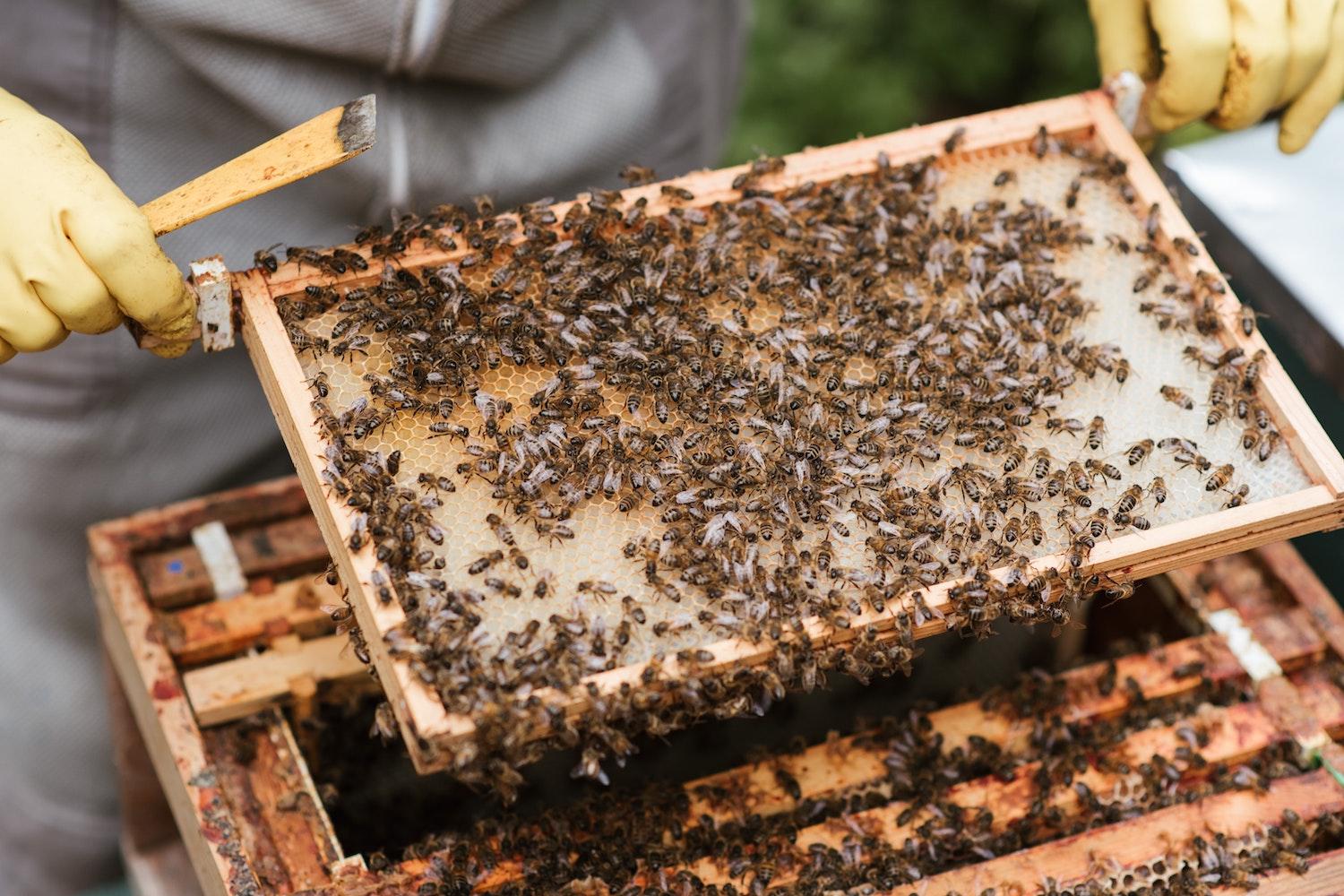
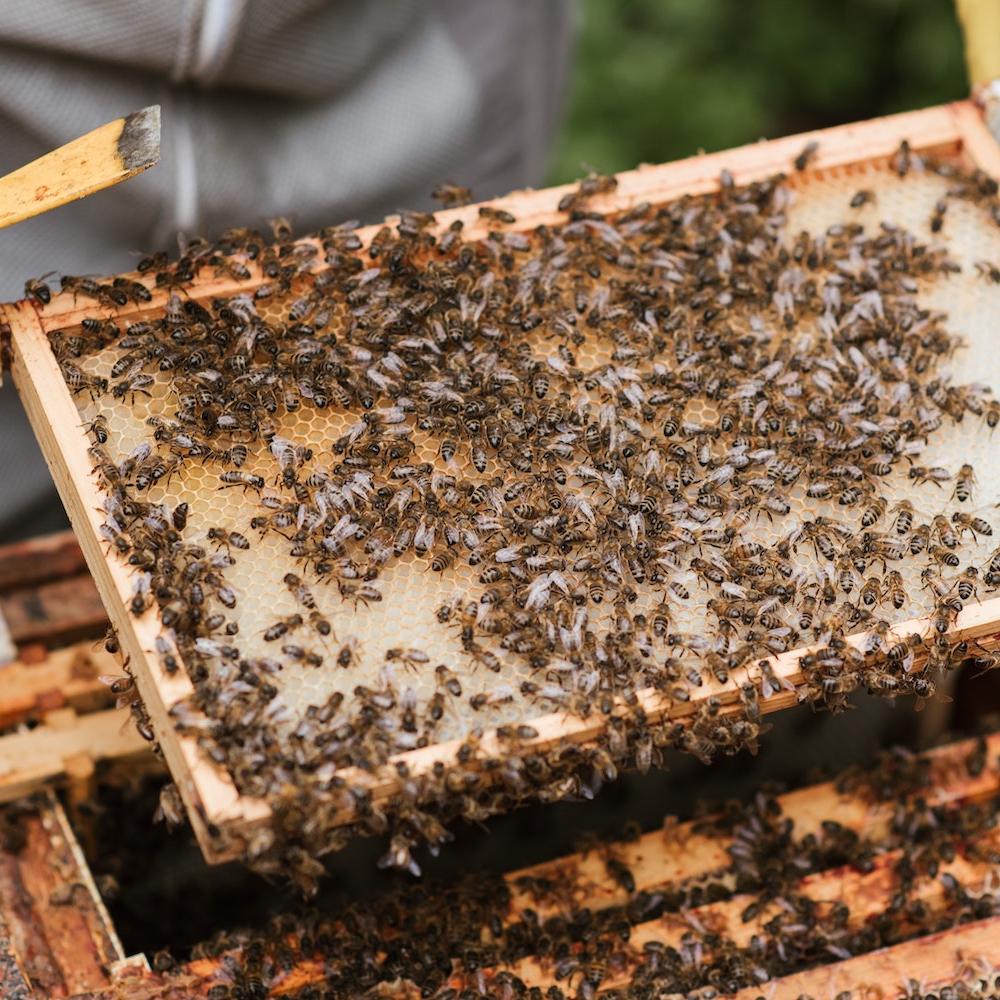
A probiotic blend can enhance honey bees’ immune resilience against environmental stress, according to a recent study. Based on the largest field trial of its kind, the microbial science company Seed Health recently announced the findings of an independent study showing the efficacy of its LX3 probiotic blend for honey bees.
The potential benefit is sorely needed as nearly half of the honey bee colonies in the United States died in 2022 — the second-highest death rate on record. The importance of honey bees to global food supplies can’t be overstated: They pollinate more than 100 of the crops humans consume, including nuts, vegetables, berries, citrus and melons.
Honey bee populations are experiencing such high mortality rates due to infectious disease, pesticide exposure, climate change and habitat loss, said Brendan Daisley, a fellow with Seed Health's SeedLabs project.
“We can’t address all of the diseases, and we can’t address all of the causal factors, but we hope to address two of them with a probiotic approach,” said Daisley, who is also a postdoctoral researcher at Western University and the University of Guelph. “The reasons why probiotics make sense for addressing the infectious disease component and the pesticide component is that we’ve shown that probiotics can increase detoxification of pesticides and increase honey bee immunity toward infectious diseases.”
Why probiotics for honey bees?
Similar to the effects of antibiotic overuse in humans, extensive use of neonicotinoid pesticides — insecticides chemically similar to nicotine that impact the bug’s nervous system — disrupts the delicate microbiome balance in honey bees. This weakens their digestive system, damages their immune function, and heightens their susceptibility to infectious diseases. When these effects are compounded by disease-carrying parasites, pests, and climate change-induced alterations in weather patterns and habitat, the result is a precipitous decline in honey bee populations.
In 2018, Seed Health established its environmental research offshoot, SeedLabs, to develop new ways to use bacteria to boost biodiversity and help ecosystems impacted by human activity to recover. That same year, SeedLabs engineered the BioPatty, a pollen patty that includes three probiotic strains scientifically proven to enhance honey bees’ immune response, increase resistance to infections, and mitigate the detrimental effects of toxic pesticides.
Testing probiotics in the hive
The latest 24-week field trial evaluated the effects of this probiotic blend when delivered as the BioPatty and as a new spray-based formula. The latter was designed to address any concerns over probiotic viability and enable the distribution throughout a hive.
The probiotics were given to more than 30 hives in a pathogen-dense region of California for a month. Both the spray and the patty resulted in benefits to honey bees that correspond with overall colony health, according to the study.
Both delivery systems got the probiotics to the hive effectively, but which method was used affected bee health differently, Daisely said.
“The spray-based probiotic nearly completely eliminated all signs of fungal disease, whereas the BioPatty wasn’t able to reduce fungal diseases as effectively,” Daisley said. “The main benefit of the patty that we determined is that the BioPatty was better at improving nutrition in honey bees.”
The field trials showed that the spray was “uniquely effective” against pathogens that target the larval bee offspring, and it reduced levels of harmful plant-sourced fungi. Whereas the patty, in addition to providing a nutrient benefit to the bees, enriched health-associated microbes in the adult bees, reduced levels of a disease-causing fungus and significantly increased the amount of healthy bee larvae. Both the spray and patty reduced the pathogens responsible for causing the deadly diseases European foulbrood and American foulbrood.
Either method of delivering the probiotic may be used, depending on the intended results, said Raja Dhir, co-founder and co-CEO of Seed Health. “Considering the distinct advantages of each method, a combined approach could be valuable,” Dhir told 3p. “Further field studies are ongoing in Canada, and we hope to determine the advantages of using both methods in the future.”
Looking ahead: An open-source solution for honey bee probiotics
Seed Health filed a patent for the LX3 probiotic blend with the intent of allowing beekeepers and farmers around the world to open-source the methods for their own hives.
“We believe innovations to support the health of our shared planet shouldn’t be proprietary,” Dhir said. “With our probiotic blend now further validated in the largest field trial of its kind, we are committed to ensuring its accessibility. By open-sourcing our formulation, we aim to offer beekeepers innovative solutions to incorporate probiotics into their regimens, helping to improve honey bee health and safeguard the future of the bees.”
Image credit: Anete Lusina/Pexels
Agency Begets Equity: A Holistic Approach to Help All Workers Succeed

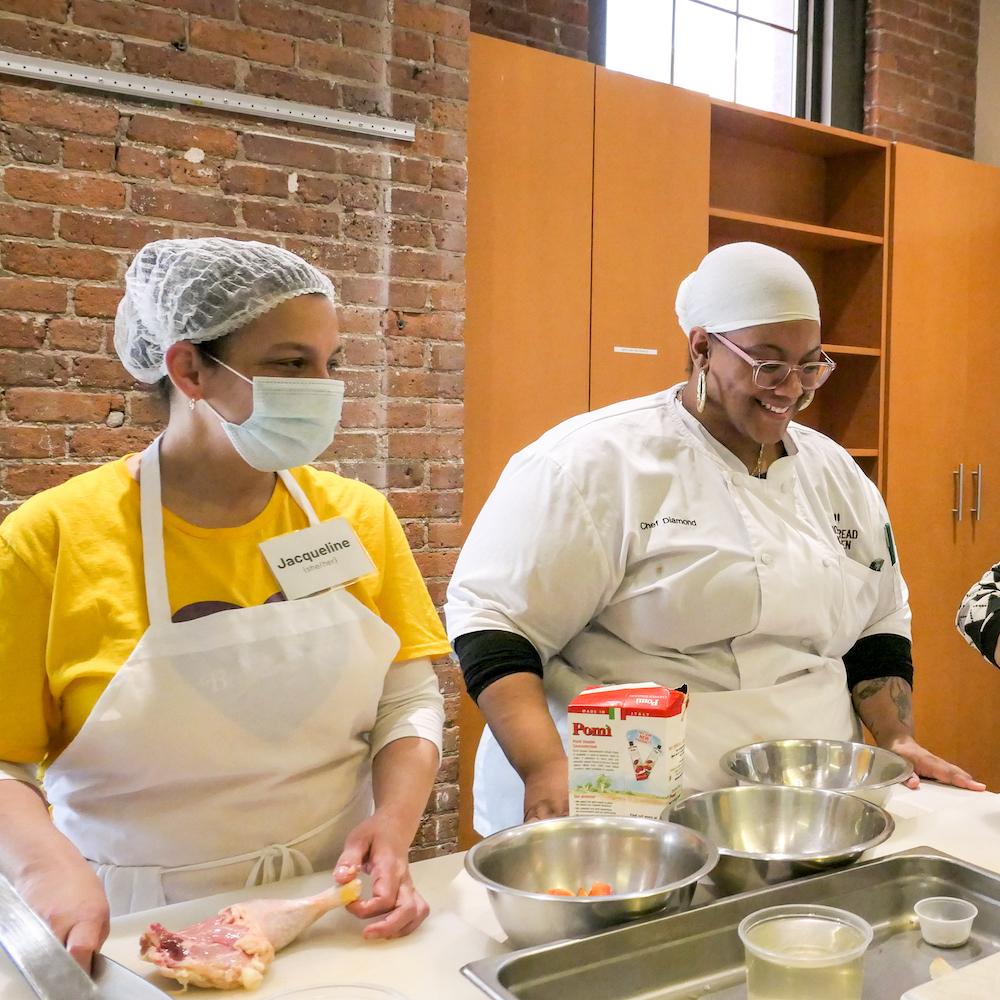
Hot Bread Kitchen is a New York City-based nonprofit organization that creates economic opportunity for immigrant women and people of color with training and job placement in the food industry. (Image courtesy of Hot Bread Kitchen)
In the last installment of this two-part article series, we uncovered the connection between agency — as in, the opportunity to make decisions, take purposeful action and pursue goals safely — and one’s ability to fully participate and excel in the workplace. We know that women and people who identify beyond the gender binary are often denied the agency enjoyed by their male counterparts. But with so many systemic obstacles in play, how do we support the women in our workplaces and drive lasting change?
Here, we’ll examine how workforce developers like Hot Bread Kitchen and organizations like Yelp collaborate on a holistic approach to building women’s agency, and the role you can play in supporting these efforts.
Building women’s agency through a holistic approach
What sets Hot Bread Kitchen apart from many other nonprofits and programs is our encouragement of women’s agency through an individualized, holistic approach. Our program members are the drivers of their own success; Hot Bread Kitchen is a supporter following each of them on their journeys. Our offering for immigrant women and people of color in New York City includes a slate of services like culinary skills training, food business entrepreneurship assistance and social services support
These services do not always seem directly related to workforce development, but they ultimately promote workforce retention by addressing people’s core needs. This, in turn, promotes long-term economic mobility, as opposed to just building the skills to land that first job.
Without the fundamental support that so many of us take for granted — think: transportation, reliable childcare, food, a safe and stable home, clothes to wear to work, somewhere to shower each day — it is virtually impossible to sustain a career, let alone get ahead in the workplace.
To solve this, Hot Bread Kitchen provides a wide range of offerings that are tailored to each individual’s needs. Examples include English-language instruction contextualized for the food industry, support for accessing childcare vouchers, healthcare referrals, and prepaid MetroCards. Our members receive a cash stipend each week they are with us, which they can use as they see fit to meet their financial needs. These offerings don’t just supplement our career programs; they enable women to put our instructional programming to good use.
Additionally, our work to place program members in jobs is highly individualized. Hot Bread Kitchen takes into account each member’s scheduling needs, family commitments and professional goals when connecting them with that first job in the food industry. To that end, we prioritize working with employers that offer set schedules with guaranteed hours, paid leave, retirement benefits, health insurance, above-average wages, paths to advancement and more.
These foundational supports can’t just be available at organizations within Hot Bread Kitchen's network in New York City. Employers must make them available to all workers in order to ensure equity — especially in fields that have long been male-dominated.
The importance of community partners
All of Hot Bread Kitchen’s programs are possible through partnerships with organizations like the Yelp Foundation, a critical member of our ecosystem of support for program members. Because we specialize in workforce training, we rely on community partners for expert, tailored delivery of the supplemental services that comprise our approach. Partners provide supplies, benefits, and educational experiences like financial coaching, mock job interviews, professional attire and much more.
In addition to providing qualitative support for our members through interviews and coaching, the Yelp Foundation provides a multi-year grant and has built a meaningful connection and ongoing relationship with Hot Bread Kitchen. In turn, Hot Bread Kitchen’s food entrepreneurship program, HBK Incubates, helps support the community by introducing and supporting new small businesses and boosting the local food industry in the devastating wake of COVID-19.
How Yelp is working for equitable agency
Yelp is also among the companies looking to support women’s agency, because it aligns with our values and propels our community forward. This starts with how we support the women and gender-nonconforming individuals in Yelp’s internal community: our employees. The company not only offers employee resource groups (ERGs) and remote work, but also benefits like healthcare (including reproductive health services and paid travel expenses for employees who live in states where the right to reproductive health services has been limited or prohibited by law), as well as caregiver reimbursement, wellness-related paid time off, back-up daycare services, mental health care, and career coaching, to name a few. All of this adds up to greater personal agency for women and gender-nonconforming employees.
Externally, Yelp is committed to advocating for gender equity and forming partnerships with organizations like Hot Bread Kitchen, which allow us to share our expertise and resources. Yelp also uses our unique platform to encourage users to patronize women-owned local businesses and help women find necessary healthcare — an issue that is intricately connected to women’s ability to succeed at work and make decisions about their personal and professional trajectories.

We all have a role to play in supporting agency and gender equity
At both Hot Bread Kitchen and Yelp, our shared goal is not only to promote the empowerment of the women and gender-nonconforming people our organizations work with, but also to drive change throughout our communities and society as a whole. Here are actions we can each take, through our organizations or as individuals, to advance equity for all workers.
Individuals and employees
Focus on supporting — and voting for — legislation that promotes equity. All workers need paid time off, sick leave, healthcare (including full-spectrum reproductive care), paid family leave, set schedules and hours, living wages, affordable childcare, and other essential services to succeed at work and lead healthy lives.
Advocate for policies and practices that promote women’s agency and gender inclusion with your employer, with the same focus as above. This is especially important for business leaders and workers with the means and resources to influence the enactment of workplace policies, or directly offer protections and benefits to workers.
If you directly employ service workers (e.g., your own nanny, housekeeper or landscaper), do everything in your power to afford them a living wage and the same resources to which you’re entitled from your employer.
Nonprofits
Take a page from Hot Bread Kitchen’s playbook and focus on centering participants’ voices when designing programs. Offer holistic, flexible support that helps people sustain a career and build long-term economic mobility.
Partner with companies and organizations that can supplement and enhance the programs you offer.
Advocate publicly to shift typical workforce development approaches to a model that recognizes the needs of the whole person.
Employers
Create a work environment that values women’s agency and gender inclusivity as part of the fabric of the employee culture by creating or stabilizing your organization’s leadership pipeline — and supporting leaders with professional development resources once they get there.
Offer employee benefits that provide the resources all working people need to succeed, and make them accessible to all employees in your organization, regardless of their role.
Partner and collaborate with, and donate to, organizations like Hot Bread Kitchen that are doing the work of enhancing women’s agency and gender equity from the ground up.
The bottom line
As women and as leaders of both a nonprofit and corporate organization, we hope our readers feel empowered to take action — both personally and professionally — to promote agency for the women and gender-nonconforming family members, colleagues and employees in their lives.
Featured image: Wini Lao for Hot Bread Kitchen
How Supporting Gender Equality in the Workplace Supports Us All

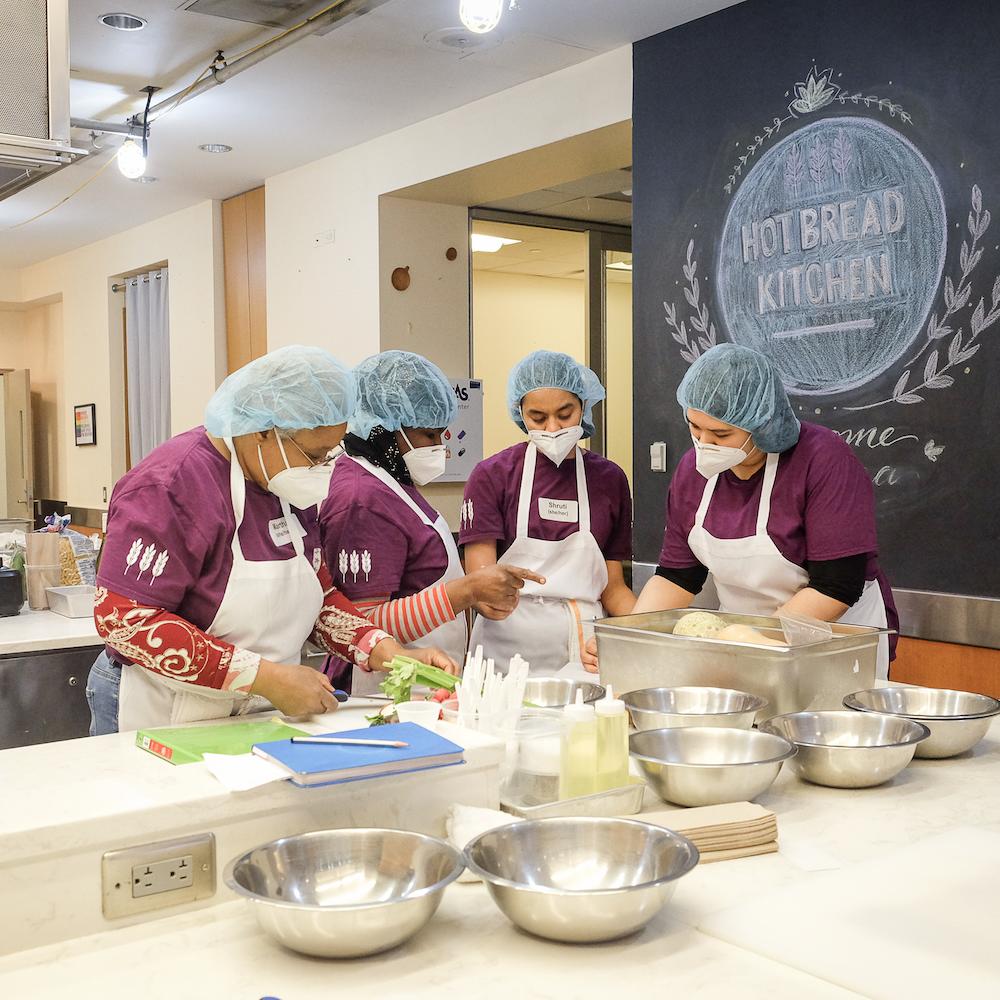
Hot Bread Kitchen is a New York City-based nonprofit organization that creates economic opportunity for immigrant women and people of color with training and job placement in the food industry. (Image courtesy of Hot Bread Kitchen)
When we look at what it takes to be successful in the workplace — and what makes a workplace successful — it becomes immediately apparent that workers need agency over their choices, goals and actions. It’s also clear that women and people who identify beyond the gender binary are systematically denied agency in the workplace — as in, the opportunity to make decisions, take purposeful action and pursue goals.
The COVID-19 pandemic highlighted myriad barriers to women’s agency in the workplace, attributable to outdated societal gender norms. In the first months of the pandemic in the United States, women’s employment fell precipitously in comparison to men. The reason? Women still tend to be more likely than men to leave their jobs or downsize their positions to take care of children and/or elderly family members when the need arises.
For those that remain in the workforce, factors limiting the agency of women and gender-expansive people abound. Women’s agency is hindered because they are more likely to fill service-industry jobs that tend to offer limited flexibility or benefits, and women with lower educational attainment are hit the hardest.
Transgender and gender-expansive people face workplace barriers due to being generally underrepresented in the U.S. workforce, and consistently enduring threats of violence, discrimination and stigma. Lack of guaranteed healthcare or paid leave, limited access to childcare, inflexible schedules, fewer opportunities to build knowledge and skills, and much more intersect to limit women and trans people’s freedom to pursue their professional goals.
This shift toward lower workforce participation among women and trans people — and the increased gender inequality that follows — has lasting implications for the future options and decision-making of workers, not to mention for younger generations. Further, lack of workforce diversity is both a result of, and leads to, lack of leadership diversity, further entrenching these conditions.
Mindful of lessons learned from the pandemic, and with the knowledge that women and gender-expansive people are critical to business’ success, we are more aware than ever that organizations and workers excel when they are led with wisdom and compassion. When ranked by their employees, 55 percent of women leaders were perceived to have these two critical traits, versus 27 percent of men. The point is not that women are necessarily better leaders, but rather that they tend to embrace leadership practices that foster more inclusive work environments for everyone, which in turn creates a bulwark against the trends listed above.
The existing gender gap in workplace leadership has real ramifications for the bottom line and for our culture. When various industries’ current leaders (who, generally speaking, tend to be men) continue to take a “traditional” approach to leadership and company policies — one that favors business-as-usual over humanity and equity — it further entrenches norms that exclude women and gender-nonconforming people from leadership positions, diminishes overall productivity, and has larger implications for generational wealth. And, as we saw in the early days of the pandemic, these approaches can push women out of the workforce entirely and limit agency for the longer term.
By embracing an approach focused on wisdom and compassion, employers — from major corporations to local nonprofit organizations — can play an important role in advocating for women’s and gender-expansive people’s agency and success in the workforce and beyond, ensuring all workers have the resources they need to excel at work and at home.
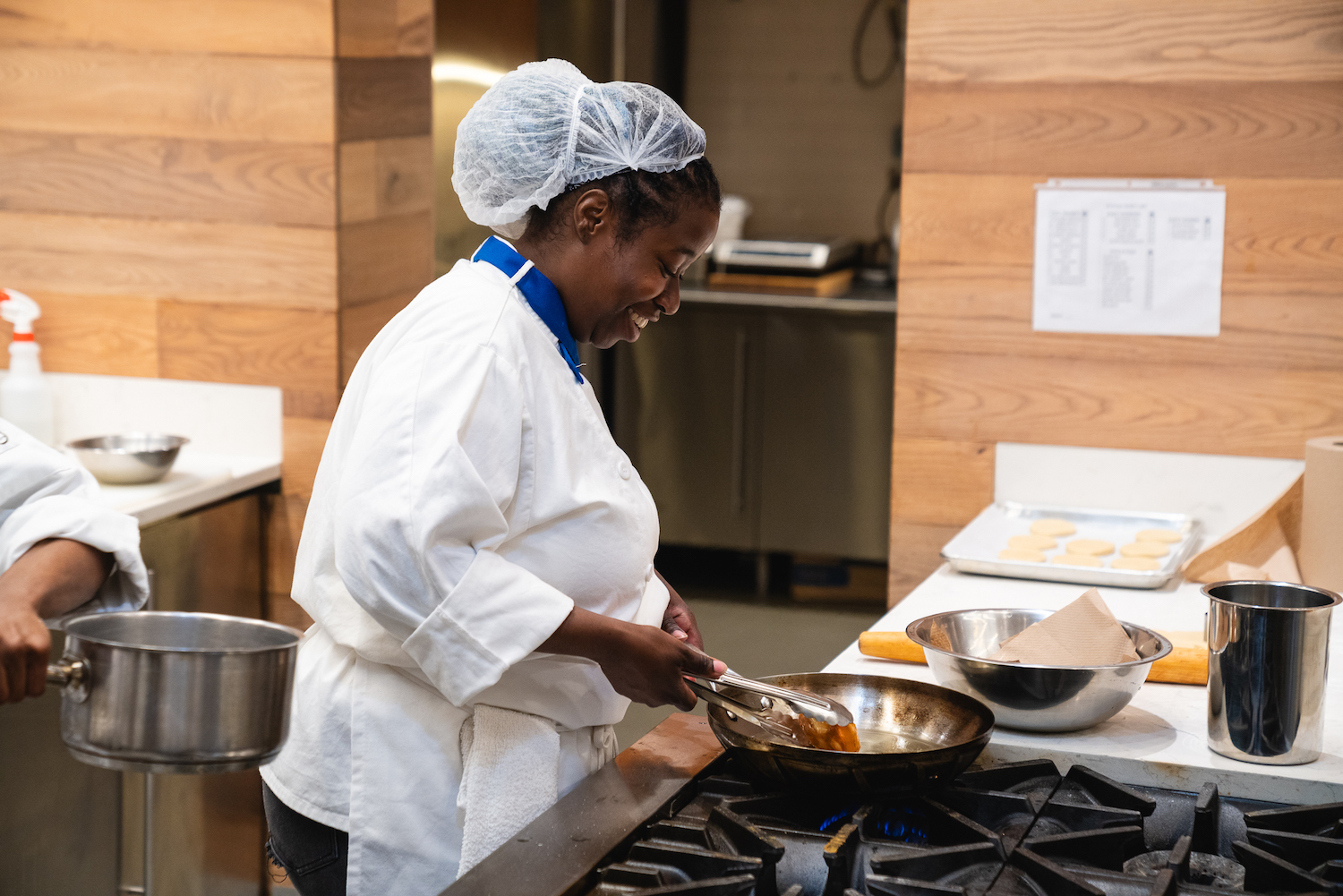
How Hot Bread Kitchen supports empowered workers
This is where Hot Bread Kitchen comes in. Hot Bread Kitchen is a New York City-based nonprofit organization that creates economic opportunity for immigrant women and people of color using the vibrant food industry as a catalyst for personal and professional growth.
We support our program members — who are disproportionately affected by social and economic barriers to wealth generation and long-term stability — as they pursue their career ambitions. We support women and gender-expansive people by providing culinary skills training and professional readiness programs, job placement, food business entrepreneurship assistance, social services support, bridge training, an extensive employer network, and more.
In the years since our founding, it has become clear that these strategies are critical tools for advancing women’s ability to find and sustain employment, grow in their careers, make choices for their families, and achieve their goals.
This holistic approach has been an evolving aspect of Hot Bread Kitchen’s model. When our organization started in 2008, we were a bakery with a simple, but important, mission: teach women bakery skills and connect them with food industry employers to secure jobs. Many other workforce development programs still drive toward a similar goal today: get people who are looking for work in the door, give them relevant skills training, and connect them with a job.
While there’s no arguing that this is an important objective, working side-by-side with our participants over the years has evolved our understanding of what it means to ensure women’s agency, a thriving career, or a meaningful public life. At Hot Bread Kitchen, we learned that for our members to be successful in the long run, we needed to do more — to take an approach that supports the whole person, not just the worker.
Empowering women to succeed in the workplace demands a comprehensive approach to overcoming obstacles, both at work and beyond. But what exactly does this look like, and what can you do to help?
The next piece in this two-part article series dives deeper into Hot Bread Kitchen’s approach, the essential role of corporate partners, such as Yelp, and how individuals can drive change. Click here to read it.
Simplifying the Path to Net-Zero With Technology

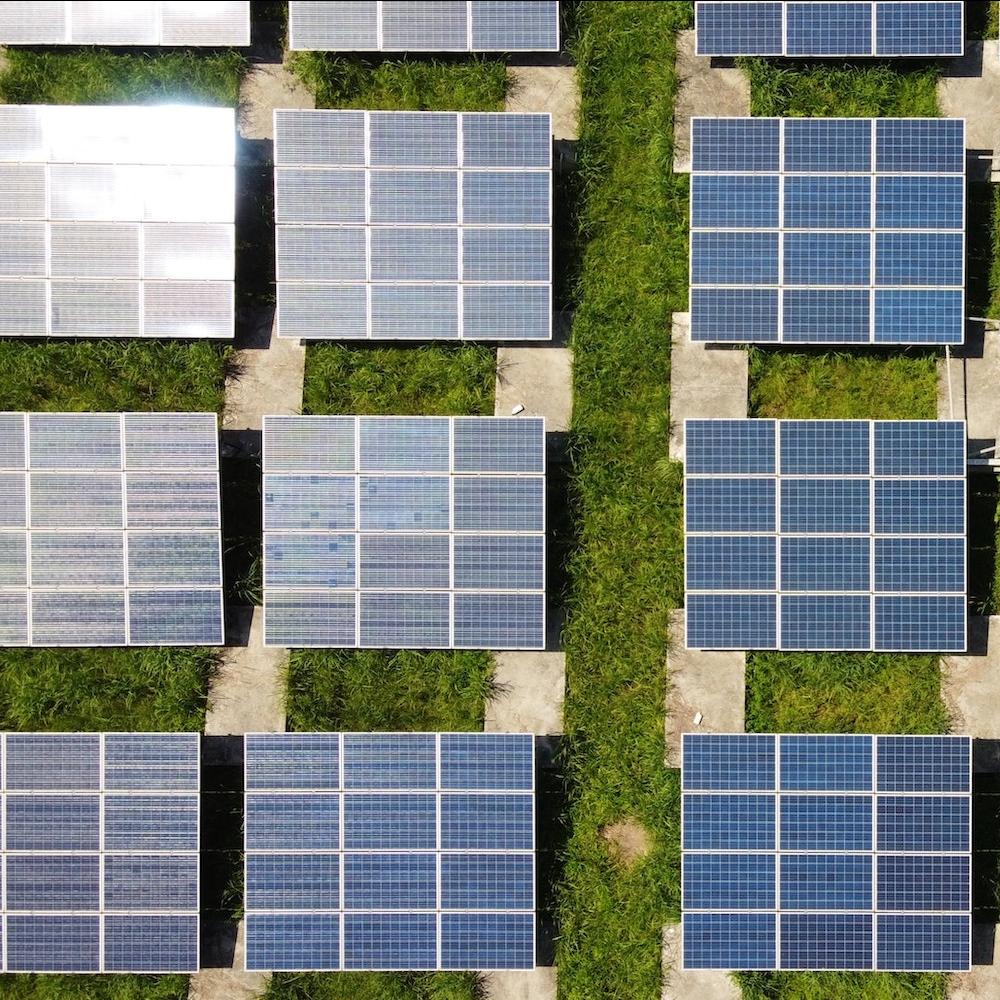
The world needs to cut greenhouse gas (GHG) emissions by almost half this decade to limit warming to 1.5 degrees Celsius as recommended by climate scientists, the United Nation warns. As companies wrestle with how best to meet their net-zero targets, technology presents an important and powerful tool to determine which approaches will make the greatest impact.
“Technology plays a key role in untangling some of those challenges and helping organizations achieve net-zero,” says Salma Bakr, product lead at the sustainability software company FigBytes.
Several mitigation options costing less than $100 per ton of carbon dioxide equivalent could reduce global emissions by at least half by 2030 compared to 2019, according to the sixth assessment report from the Intergovernmental Panel on Climate Change (IPCC). Examples include using more renewable power generated from sources like solar and wind, transitioning to more fuel-efficient vehicles, and using more energy-efficient technologies.
That’s good news for the more than 90 percent of business leaders who say they prioritize long-term decarbonization. “Companies play a crucial role in tackling climate change and benefit from decarbonization by reducing risks like extreme weather events and policy changes,” Bakr says. “In the long run, and as more low-carbon solutions are adopted and become more affordable, decarbonizing a business saves operational costs and enhances efficiency, for example, where you pay lower bills for your energy and waste.”
Why technology is key to unlocking solutions for climate action
In the context of decarbonizing businesses, technology comes under two categories, Bakr explains: digital technologies that enable a net-zero future, and physical technologies for climate mitigation or adaptation.
These technologies complement each other in support of net-zero targets. For example, digital technologies enable efficient and scalable processing of climate data, allowing for more informed problem detection and decision-making. They also allow companies to evaluate multiple decarbonization solutions virtually and chart the best path forward, Bakr says. Together, digital technologies have the potential to reduce emissions by up to 20 percent by 2050 if scaled and adopted in high-emitting sectors like energy, materials and mobility, according to the World Economic Forum.
Physical technologies, on the other hand, enable climate mitigation and adaptation. The IPCC's sixth assessment report shows that several of these technologies have high potential for GHG reduction at scale. For climate mitigation, this includes solar and wind power, energy-efficient appliances and lighting, and fuel-efficient vehicles. For climate adaptation, a key example is building resilient power systems which provide a diverse and stable energy supply.
How digital technologies can accelerate progress to net-zero
Digital technologies enhance decarbonization efforts in multiple ways, Bakr says. Even more good news: Organizations of all sizes across every industry already use many of these digital tools to ease their progress toward strategic goals — making it fairly seamless to digitize their approach to climate action as well.
For example, most businesses use foundational technologies to support daily tasks of measurement, reporting, and basic analytics for data-driven insights. Examples include enterprise resource planning (ERP) systems, customer relationship management (CRM) systems, and supply chain tracking systems.
“This means organizations don’t have to start from scratch,” Bakr says. “For example, they can add sustainability solutions ‘on top’ of their existing systems.”
Organizations can also use decision-making technologies as part of the daily course of doing business, where machine learning can be leveraged, for example, to imitate how humans learn and ingest new data, which can improve decision-making accuracy, Bakr says. Such technologies also allow organizations to use historical data to forecast future events, or provide actionable recommendations to inform actions around decarbonization.
Another group of digital technologies increasingly embraced on the decarbonization journey are sensing and control technologies. These range from automation, robotics and drones to enhanced connectivity through the Internet of Things. By deploying these technologies, companies can more easily collect data from physical systems and more accurately control things like office temperature, humidity and lighting based on occupancy.
Yet another category are enabling technologies that support organizations to operate more efficiently. Examples include cloud computing and mobile communication, which allow organizations to scale their resources on-demand.
Technology advances ease climate accounting
“Tracking progress is crucial,” in pursuit of climate goals, “as net-zero is all about beating the clock and making progress,” Bakr says. “That’s why climate action needs climate accounting first, including a comprehensive emissions inventory. And the main challenge in establishing an emissions inventory is a data problem: data collection, consolidation, validation, verification and so on.”
This is where technology is an asset, she explains. A climate accounting solution collects, validates and verifies activity data, and conducts basic emissions modeling, reporting and analytics. Making that solution cloud-hosted “helps scale data collection, cross-collaboration across teams and geographies, and stakeholder engagement, where you can collect data from anywhere in the world and scale your computations as needed,” Bakr says.
Climate accounting systems can be integrated with decision-making technologies such as machine learning to augment the intelligence of an organization’s analytics, for example, to ensure the right emission factors are applied to calculate emissions data, she adds.
Companies and organizations that have set science-based targets should also keep watch on the “Progress Framework" under development by the Science Based Targets initiative, Bakr advises. It aims to advance the measurement, reporting and verification of science-based targets, providing clear and standardized expectations and guidance on how to measure, report and verify climate action progress against those targets.
This framework will support transparency and integrity by holding companies and financial institutions accountable for their climate targets. Development is expected to be completed at the 2023 U.N. Climate Change Conference (UNFCCC COP28) in Dubai in December.
Overcoming the challenge of future scenario planning
After the initial steps of streamlining a baseline emissions inventory and setting net-zero targets, an important but often challenging part of the decarbonization journey is the ability to forecast future emissions scenarios and understand associated risks and opportunities. “Many organizations find challenges in defining and analyzing net-zero scenarios,” Bakr says. “It’s a tricky and complicated process.”
But organizations can overcome that challenge by better understanding what is involved in a future climate scenario, she advises. “Scenarios should challenge business-as-usual assumptions about the future, but also illustrate a credible story comprising possible and consistent future events. Scenarios should also be relevant, meaning they explore future insights relating to the various implications of climate-related risks and opportunities. They should also be distinctive by exploring different permutations and combinations of key factors impacting future developments to generate multiple decarbonization alternatives for the organization to select from.”
Again, an organization can turn to technology to do this. “A solid climate accounting solution, coupled with decision-making capabilities, can help an organization forecast and visualize the future emissions associated with various scenarios based on the various data inputs considered,” Bakr says.
At the same time, technology isn’t a panacea, and it also has its own footprint to consider. “As we consider various technologies in the transition to net-zero, we need to also understand that those digital and physical technologies do produce emissions in one way or another,” she adds. “We need to take a systemic approach to tackling emissions reduction and stay on top of the latest research and development efforts.”
Inaction is not a possibility
Taking action is the only option, Bakr points out. “The journey to net-zero is bumpy but inevitable,” she says. Organizations can set themselves up for success with a solid climate action strategy that aligns net-zero targets with the latest climate science, and leverages technology to speed up the transition.
“This will make the net-zero journey as efficient, effective and consistent as possible,” she says. Crucially, the goal should be to invest in net-zero innovation that extends beyond any single organization’s value chain: “Focus on bold reductions, first and foremost. And if your progress strays, make sure you realign by identifying more reduction potentials.”
This article series is sponsored by FigBytes and produced by the TriplePundit editorial team.
Image credit: Anders J/Unsplash
It’s Time to Invest in Sustainable Rice
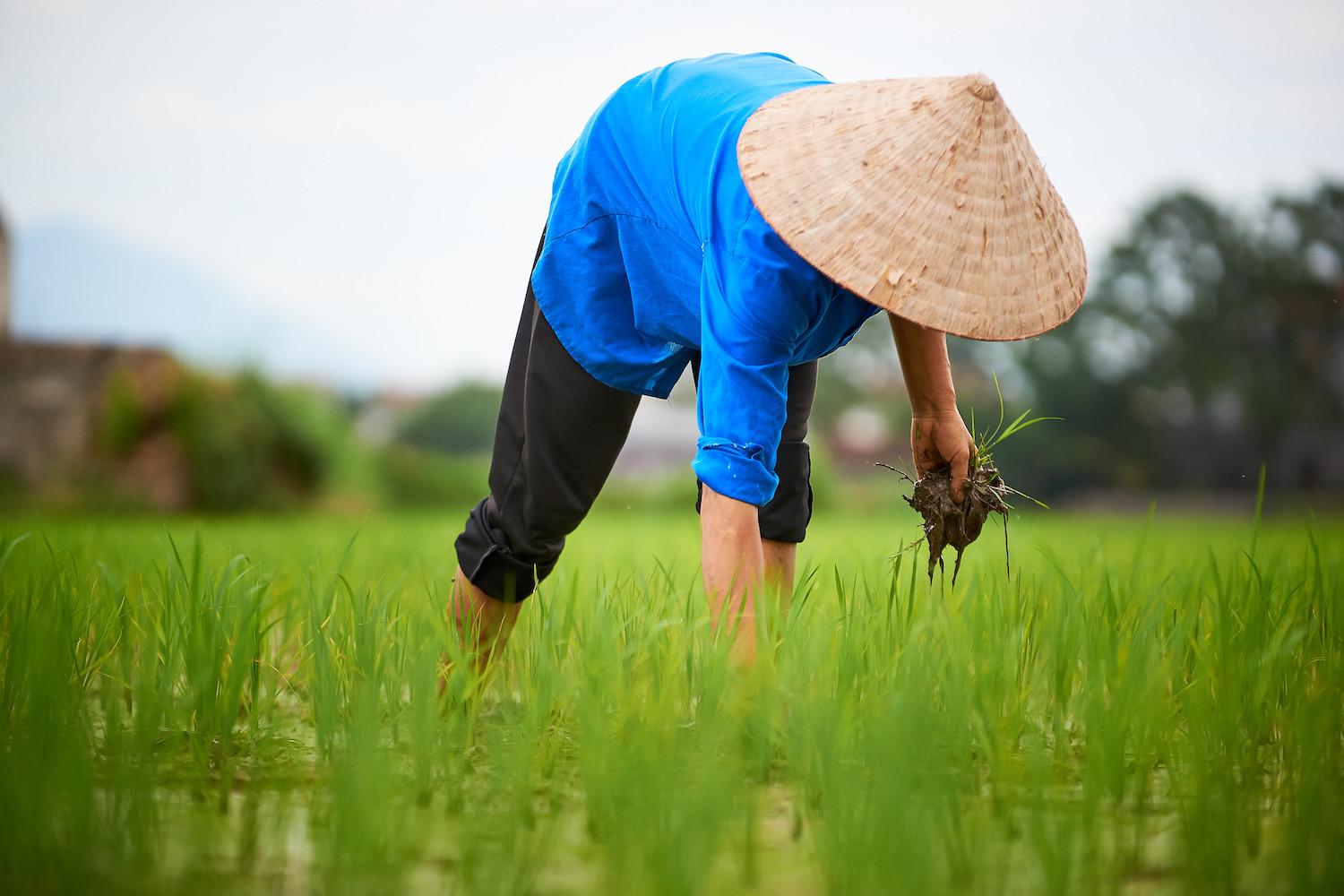
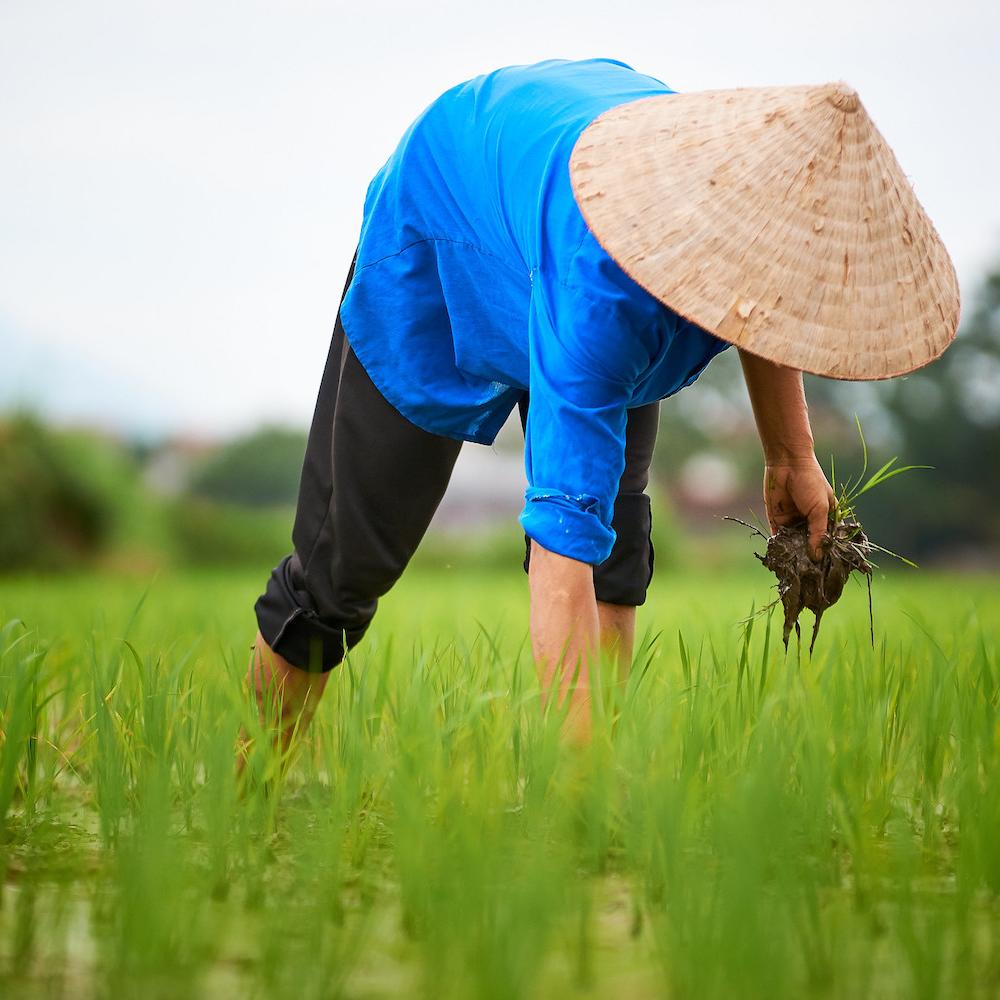
A Vietnamese rice farmer weeds her field by hand. (Image: Bryon Lippincott/Flickr)
Vietnam’s Mekong Delta region has served as the country’s breadbasket for years. Known for fertile soil, the area grows more than half of all rice produced in the country, a staple in the Vietnamese diet. In 2016, however, the delta experienced a devastating drought, leaving 600,000 people without access to fresh water. Rice yields had already been falling for seasons, but the drought represented a tipping point for many farming families. Degraded land, lack of water and pollution caused nearly 1.1 million people to migrate from the region.
Climate change threatens rice cultivation worldwide
Unfortunately, this is only the beginning of what’s to come worldwide. Climate-induced crises are threatening farmers’ livelihoods and exacerbating global hunger. Approximately 3.5 billion people rely on rice as a staple in their diet, and the grain provides around a third of the calories consumed in low- and middle-income countries. Rice is also becoming increasingly popular in the West, now commonly found in pet food, beer, cereals and other items to meet the rising demand for gluten-free products.
All of this is impacted by the exponential growth in the global population, and with it, the demand for rice. Rice production will need to increase by an estimated 25 percent by 2050 in order to meet global needs. Meanwhile, approximately 15 million to 20 million hectares of land may suffer water scarcity due to rising temperatures, threatening to greatly reduce the yields and nutritional value of rice harvests.
Increased water scarcity events would be devastating for rice cultivation, as the crop is extremely water-intensive, each kilogram requiring between 2,000 and 5,000 liters of water (40 percent of the world’s total irrigation water). Rice paddy fields and reservoirs have caused a 233 percent increase in manmade wetlands while natural wetlands have declined by 35 percent, throwing everything out of balance.
Rice is also a significant contributor to global greenhouse gas (GHG) emissions. In fact, rice’s carbon footprint is similar to the international aviation industry. Emissions are largely caused by the conventional field flooding farming method, which prevents oxygen from penetrating the soil and leads to the growth of harmful, methane-emitting bacteria. Additional methane is released from the rotting rice straw left over from the crop in conventional rice farming.
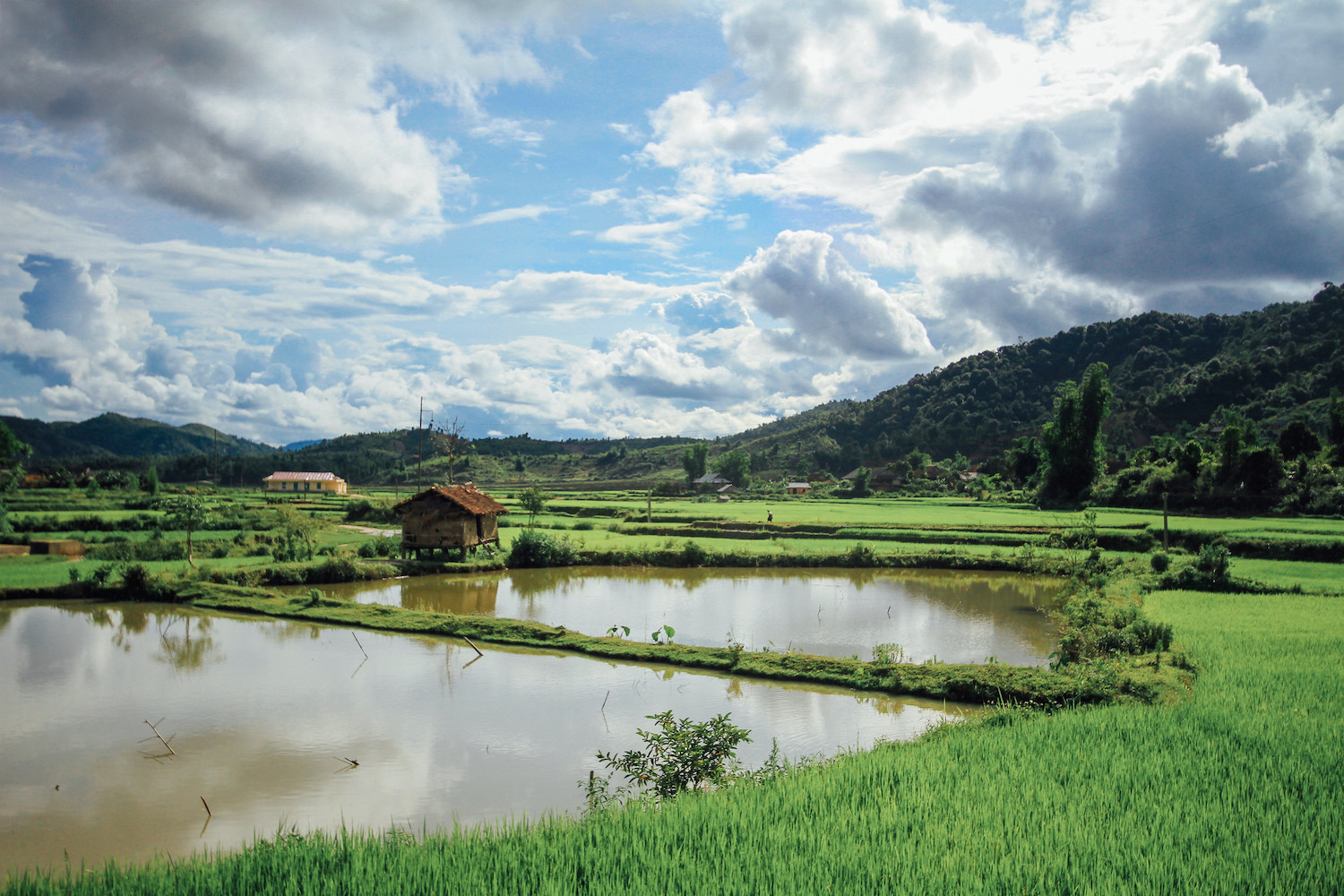
There is a better way, but the private sector needs to invest in it
If we continue cultivating rice using these methods, climate change-related weather incidents and exhausted resources will certainly cause a shortage, likely leading to a hunger disaster on a global scale.
After years of research, trial and error, there are now proven methods of sustainable rice production that are adaptive and resilient to climate change, and produce the same yields as conventional cultivation. A study in the An Giang province in Vietnam, the world's fifth largest rice producer, compared harvests between farmers using the more sustainable wetting-and-drying (AWD) field method to those using the conventional field flooding approach. Yields were almost identical, and the AWD method emitted less greenhouse gases and required fewer seeds and fertilizer.
These green farming techniques are the only pathway that can maintain rice productivity and adapt to rising global temperatures. But more private-sector finance is needed to support and grow these programs. Fortunately, it is no longer a risk for companies to shift to these sustainable methods. In fact, it’s a business imperative.
At the Global Environment Facility, investments totaling over $600 million continue to grow from the initial cluster of Asian countries and into West Africa under our programs — demonstrating scalability, replicability and financial support from the private sector, which is a vitally needed element for equitably transforming systems.
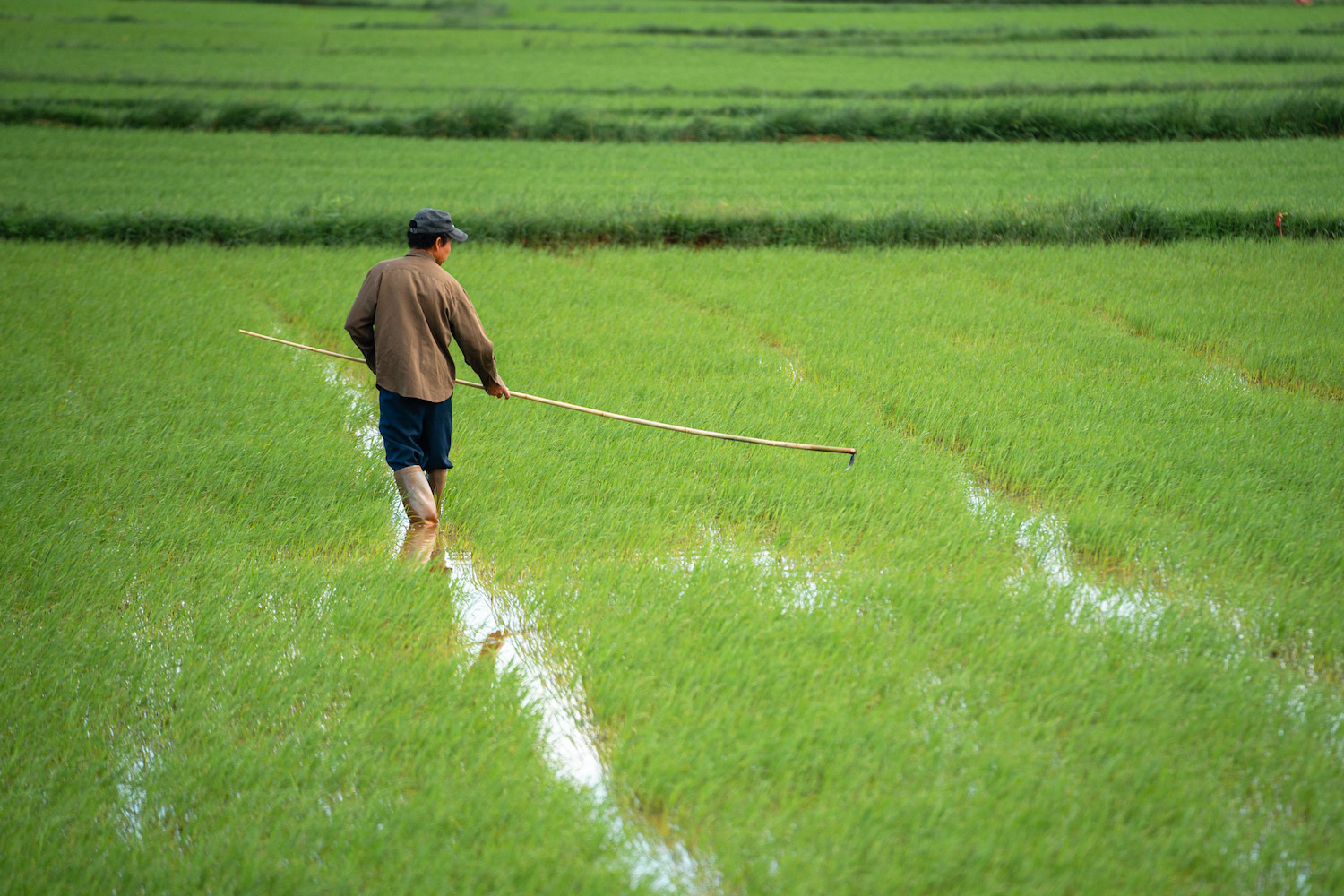
Why invest in sustainable rice?
Here are some of the top reasons why the time is now to invest in sustainable rice.
Reducing GHG emissions. There are now proven methods to mitigate rice’s methane emissions by up to 70 percent using simple changes in farming techniques. These modifications include removing rice straw from the fields after harvest, new fertilization and soil amendment regimes, and careful control of the timing, duration and extent of rice field flooding. These transitions are possible through the training and support of rice farmers at the ground level.
Blended-finance to de-risk investments. There is growing attention on blended finance opportunities to de-risk private-sector investment. Instead of pure grants, which are always in short supply, these investment tools catalyze private-sector investment and foster replicable projects. By combining private and public finance sources — such as commercial investors, donors, and/or multi-lateral trust funds like the Global Environment Facility — project design teams can deploy credit lines, loan guarantees, equity investments and other innovative approaches. Many investments can be aggregated into a larger facility or funding program to help scale and attract private finance in markets where the risks are too high for conventional financial products or local institutions alone.
Climate resilience. Researchers have discovered effective methods of reducing rice’s reliance on water that are significantly more efficient than conventional farming techniques, creating more climate resilience. For example, a sustainable rice program in Vietnam used a micro-irrigation system that allows water to drip slowly to plant roots instead of the conventional field flooding method. This resulted in water savings of 60 percent to 70 percent and highlighted the power of technical farming assistance to reduce resource exhaustion and provide more consistent yields.
A global network of support. Sustainable rice farming programs are backed by a network of international organizations including the United Nations, the World Business Council for Sustainable Development, and my organization, the Global Environment Facility. Programs such as the Sustainable Rice Landscape Initiative are well underway to help private companies make the shift from conventional rice farming to green techniques in order to meet the Paris Agreement’s GHG emission targets. The Sustainable Rice Platform helps create customized finance approaches and climate transition blueprints.
Small farmers are ready. Training and capacity-building for farmers and smallholders have been underway for several years now, paving the way for a systemic transition to sustainable rice production and providing additional assurance for private investors who were reluctant to invest in a country that is too early in this process. Support for farmers can take many forms, such as teaching mechanized harvesting methods in Nigeria, which prevented almost half a ton of food loss and increased farmer profits by approximately $200 per hectare.
The time is now for the private sector to invest in sustainable rice production — not only to meet global climate policy requirements, but also to ensure that rice farming is able to adapt to our changing planet and that businesses remain profitable. Conventional rice farming methods are a ticking time bomb. The foundation has been laid in terms of developing proven techniques, working with governments to shift national policies, and training farmers around the world. It’s time for CEOs to take the leap, not only to save their businesses, but also to prevent climate and hunger disasters.
This Social Enterprise is Improving Public Toilet Infrastructure in Bangladesh's Urban Centers
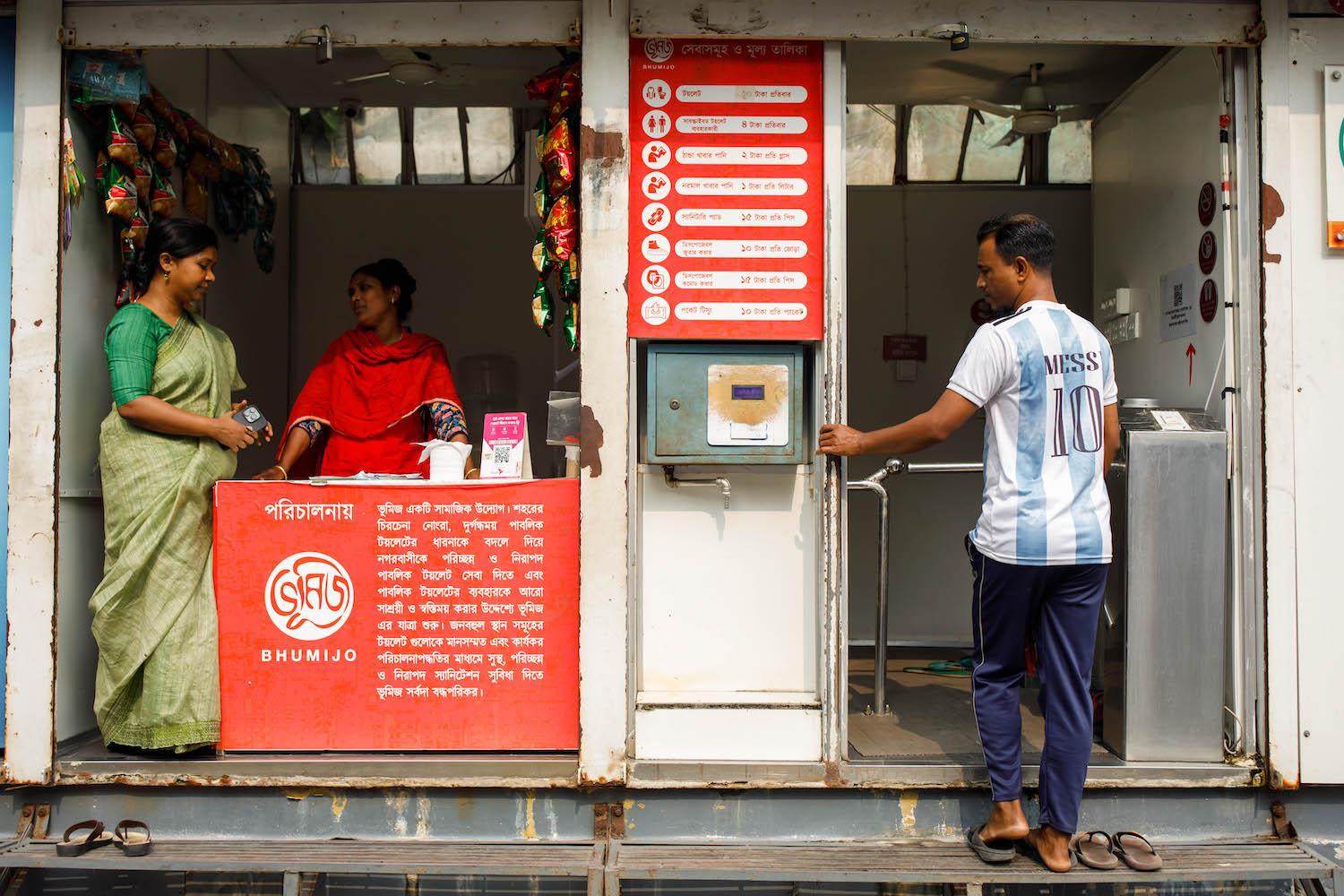
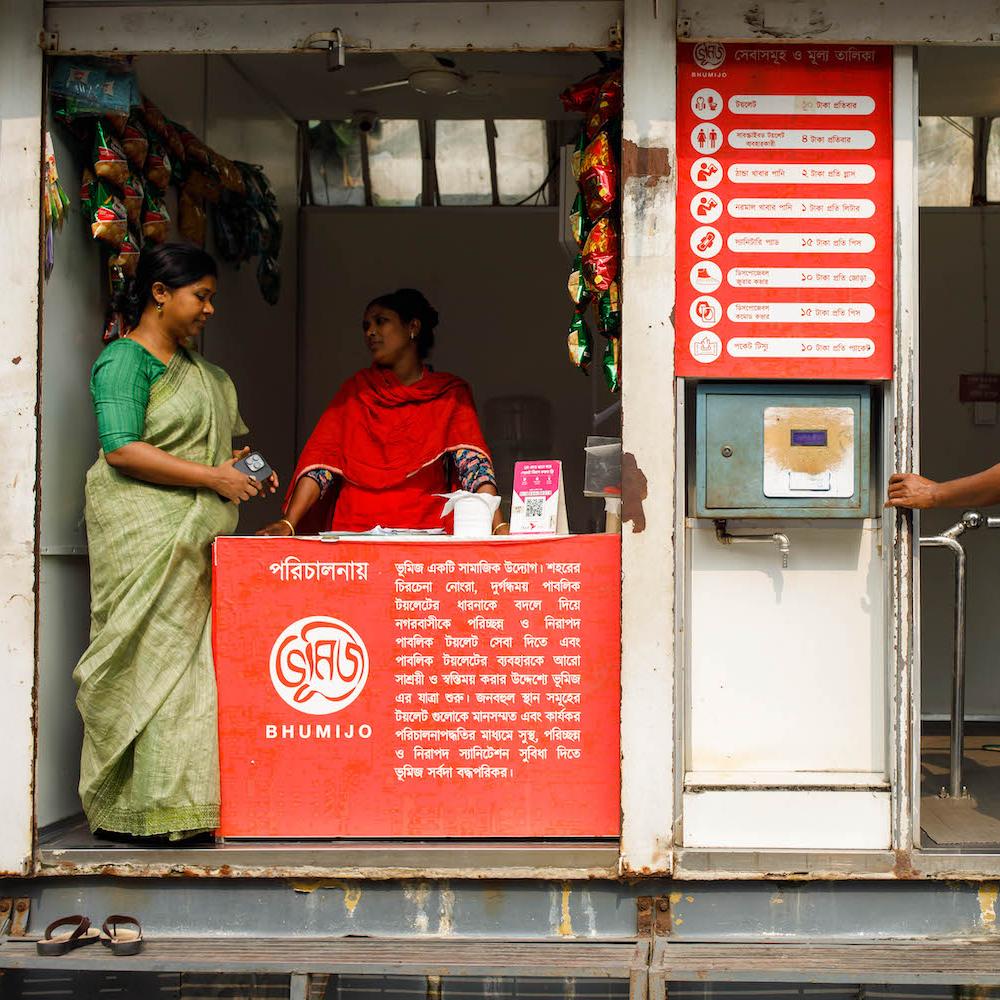
Bhumijo's public facilities are monitored by on-site maintenance staff to ensure they are clean and safe.
More than 23 million people live in the greater Dhaka area — which includes suburban areas beyond the “city proper” — making Bangladesh’s capital the ninth-largest and seventh-most densely populated city in the world as of 2022. Its population, which includes over 5 million daily commuters, is projected to exceed 27 million by 2030. Yet Dhaka’s residents have less than 100 public toilets available to them.
Two city corporations — self-governing entities responsible for the north and south of Dhaka municipality, respectively — are responsible for the facilities and charge entry fees. Yet many of the public toilets are unusable, often with overflowing and defunct toilets and no soap or clean water.
Many working women in Dhaka spend 12 to 16 hours a day outside of their homes, and 80 percent of the city's women report not drinking or drinking less water due to the drought of safe, functional public toilets, according to a survey conducted by sanitation services provider Bhumijo. Such difficult decisions pose immediate public health concerns, including a rise in urinary tract infection conditions and other kidney-related diseases.
Farhana Rashid, trained as an architect and urban planner, returned to her home city of Dhaka after studying in Sweden and saw few gender-responsive development initiatives. Having firsthand experience with Dhaka’s public infrastructure and resources, Rashid — along with her husband, architect Masudul Islam Shammo — founded Bhumijo, the first and sole social enterprise that builds public toilets in Bangladesh’s urban centers.
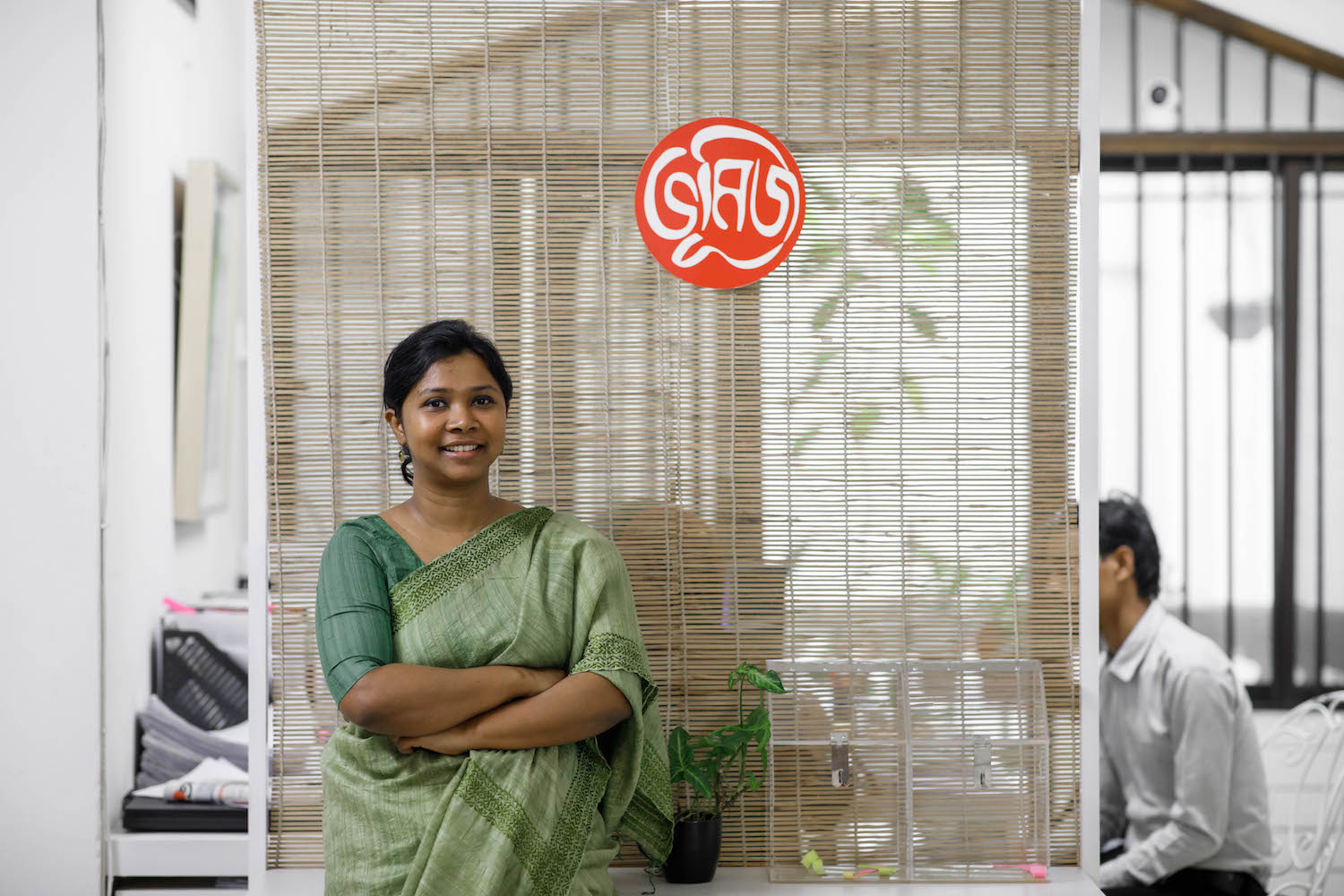
Bhumijo currently operates and maintains 33 sanitation centers across Dhaka, as well as the cities of Benapole, Narayanganj and Khulna, with a goal of reaching 1,000 facilities by 2030. Individuals may pay per use or by monthly subscription, with prices ranging from 5 to 10 Bangladeshi Takas per use, or less than a cent in U.S. dollars. These fees are determined by city regulations and are equivalent to the cost of using a city corporation washroom, Rashid told TriplePundit. The company also renovates and maintains several restrooms that were built by the city corporations.
Bhumijo’s restrooms also include diaper changing stations, ablution and leg-washing stations, accessible toilets, and private sections for both women and gender non-conforming people. Some facilities also offer showers, laundromat services and drinking water dispensers.
Beginning with five employees in 2017, Bhumijo’s team is now about 55 strong, including some of Rashid’s friends and family who volunteered from the beginning. The name Bhumijo is a Bengali word meaning “from the earth.” The name alludes to our human and community needs’ inextricable connection to the earth, Rashid said. “We made Bhumijo not only for public sanitation, but in the broader aspect to protect the health of the people of Bangladesh.”
The company grew with support from Transform, a Unilever-funded accelerator for social enterprises in Asia and Africa, as well as from the U.K.’s Foreign Commonwealth and Development Office and from professional services and accounting firm EY. GSMA’s Mobile for Development grant also supports Bhumijo in digitizing its facilities. Several of these efforts are in the trial stage, including digital entry and payment options, remote monitoring in addition to on-site maintenance staff, and an app that displays the real-time occupancy and indoor air quality of the nearest facilities.

Still, shifting the perception of public restrooms takes time, Rashid said. “People are used to locating public toilets by smell alone.” Accordingly, most were initially wary of Bhumijo’s development in areas near their homes, markets or parks.
“At the beginning, we struggled to find places to build,” she said. “Everyone thought the area would become so dirty that no one could live there. We still sometimes face that assumption, but it has been reduced.”
As Bhumijo’s facilities expand, the company continues to identify areas to strengthen its system. For example, it can now manage payments in cash or online, and it expanded its water reservoirs to maintain adequate supply to all locations, Rashid said.
Other goals include finding more development partners, such as government agencies and mobile operators, to expand to high-density areas like bus and train stations and provide internet at facilities to support mobile payments. On a broader scale, Bhumijo is in discussion with policymakers about the most appropriate means of operating public toilets, from leasing them out to establishing maintenance and sanitation schedules.
Image credits: Bhumijo
This Model Makes Energy Storage Accessible for People of All Incomes
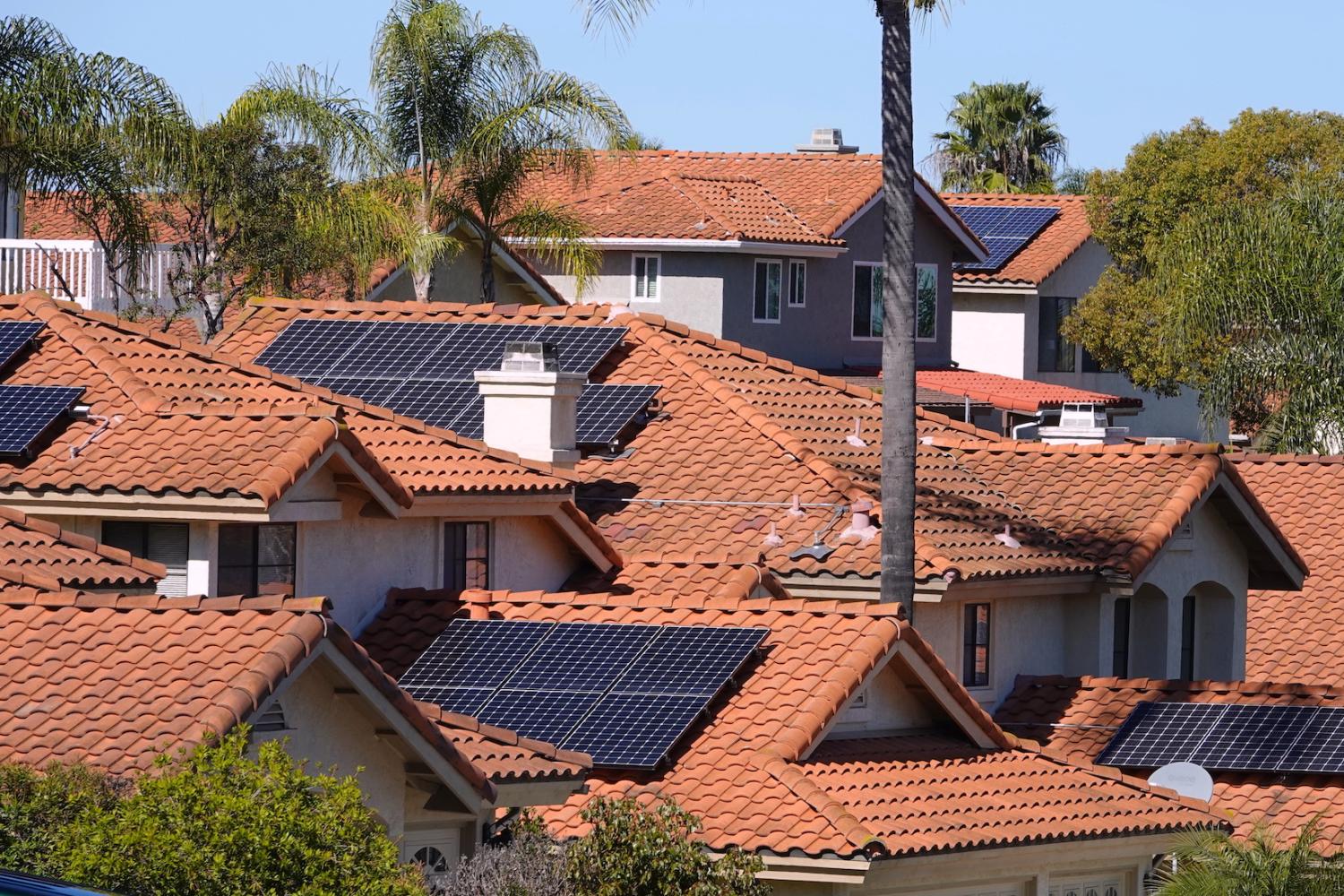
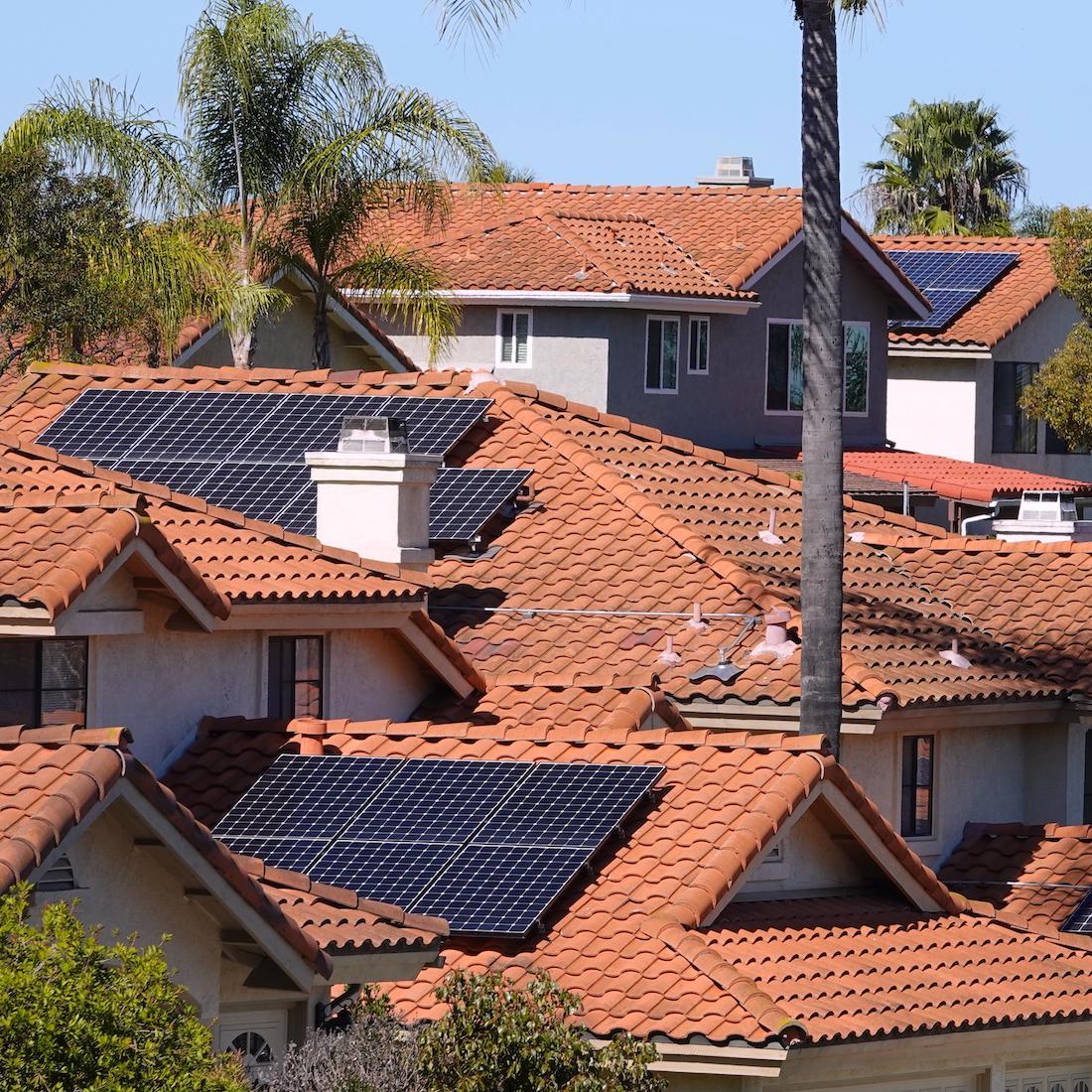
Rooftop solar and battery energy storage can help households deal with rising power prices and increasingly frequent outages tied to natural disasters. But solar and storage systems are economically out of reach for many people — particularly those who would benefit most from the extra help on their monthly bills.
Electriq Power is looking to close the gap by partnering with municipalities and nonprofits to make solar and energy storage systems available to residents of all income levels.
"We try to make it the same for each and every one, whether you're the wealthiest person in a community or the lowest-income person in the community," said Frank Magnotti, CEO of Electriq Power.
Powering California communities with solar and energy storage at no money down
Electriq Power partners with municipalities to offer solar and energy storage solutions to their residents. Electriq provides all hardware, software and services — including solar panels and batteries, as well as smart battery software, installation services and grid connectivity.
The company also lends its marketing prowess to help municipalities get residents signed up, but the programs are branded by the city or town — providing further assurance to residents. "The municipality provides a really key link here," Magnotti said. "The homeowners get the confidence that this program has been vetted by the municipality."
The program is open to homeowners, as well as renters in multifamily units whose landlords have opted to participate. Residents can opt into the program with no upfront cost, no credit checks and no property liens. And 25-year power purchase agreements, provided by Electriq and vetted by participating municipalities, allow residents to power their homes with solar for about 20 percent less than what they pay for their typical energy bill.
"They're getting a free battery on top of that — and again, at no money down — so it's a pretty strong program for low-income communities who would not be able to afford this," Magnotti said.
Electriq has three of these programs up and running in Parlier, Santa Barbara and San Luis Obispo, California, where participating households are connected to form solar microgrids that Electriq calls sustainable community networks, or SCNs.
Within these networks, Electriq's PowerPod 2 battery systems are connected to rooftop solar installations as well as the local energy grid. Solar panels charge the batteries during the day, and smart battery software deploys that power back into the home during peak demand times to insulate the household from sharp spikes in power pricing. Bringing energy independence to more households also helps reduce the burden on the local energy grid, making it better equipped to handle demand fluctuations and capacity constraints.
Along with accessing energy at cheaper and more predictable prices, residents also gain peace of mind in knowing their homes will still have power in the event of a local outage.
"What is not known by a lot of people is that if you have solar and the grid goes out, you can't use your solar," Magnotti said. "But if you have a battery system that works with the grid, you can then keep on [using] the solar and storage without the grid being there at all."
The programs are catching on fast. More than 1,000 residents have expressed interest in Santa Barbara County's home power program since it launched in October of last year, Magnotti said. Electriq is looking to establish more community solar networks across California, backed by $300 million in financing from an unnamed U.S. clean energy company secured in March.

Working with nonprofits to bring more solar and storage online
Electriq also helps nonprofits create solar and energy storage programs in the communities they serve. In Puerto Rico, the company is the sole service provider for the nonprofit Barrio Eléctrico, which works to bring solar and storage systems to low-income residents in the coastal town of Isabela, about 70 miles west of San Juan.
Similarly to how the home power programs function in California, Isabela residents can opt into rooftop solar and battery energy storage with no upfront cost.
The batteries' off-grid functionality is particularly compelling for an island that's frequently affected by storms and extreme weather. After Hurricane Fiona struck last fall, "our homes were the only ones that had power," Magnotti told us. The company has also been in touch with the Federal Emergency Management Agency (FEMA) about how to use its battery systems for emergency support, he said.
Further, using stored power during peak times can significantly lower household energy bills — another huge plus for the island, where electricity rates are among the highest in the U.S.
The company provides services to SEDC Solar for a similar program that makes solar and storage accessible to homes, churches, and businesses in some of the lowest-income neighborhoods of Washington, D.C.
A triple win for residents, municipalities and the private sector
In March coverage of Electriq, Anne Fischer, senior editor of the solar-focused publication PV Magazine USA, breaks down how all parties benefit from this type of model. "Electriq or another financial party own the battery, and they get the federal tax credit," she wrote. "The benefit to Electriq, or other third-party, is that they can use the battery at specified times to send power to the grid."
Meanwhile, residents get the benefit of purchasing solar power at a cheaper price than conventional power — lowering their bills and reducing the carbon footprint of their home energy use, while also knowing they can maintain power in the event of an outage.
The model is, of course, not a panacea that can solve all of a community's decarbonization and grid stability challenges, with limited availability for renters being a clear gap to fill. But when coupled with other solutions like community solar — which allow renters to share solar power from community installations — home power programs like those from Electriq can help cities to decarbonize, enhance grid resilience, and offer lower and more stable energy prices to their residents.
"What we pride ourselves on is this automated software where the customer gets very involved if they want and can change things on an hourly basis, or you can kind of set it and forget it," Magnotti said. "The key is: How do you have software that makes it easy for the consumers? They don't have to think that much, but it still provides these benefits for them."
Image credits: Simone/Adobe Stock, Kindel Media/Pexels and Electriq Power
Target Gets a Second Chance on LGBTQ Rights


Leading U.S. retailer Target disappointed human rights organizations earlier this year when it failed to push back against a wave of aggressive anti-LGBTQ behavior related to its Pride Month merchandise. Now Target has another chance to get it right, and the stakes are high.
Target backs down when anti-LGBTQ activists come calling
Anti-LGBTQ activists confronted staff at several Target stores in May, during the runup to Pride Month. Instead of pushing back, Target removed the offending displays. “Target is pulling some LGBTQ merchandise from stores that it rolled out for Pride Month after confrontations with customers,” Jessica Guynn of USA Today reported on May 23.
Guynn cited a statement from Target, in which the company referred to “threats impacting our team members’ sense of safety,” as well as "volatile circumstances” and “confrontational behavior” that influenced its decision to remove merchandise.
That decision was roundly criticized by hundreds of human rights groups in a letter organized by the Human Rights Campaign on June 5. However, some saw it as a case of better safe than sorry. The confrontations at Target go beyond the actions of a few scattered individuals. They reflect a dangerous environment of anti-LGBTQ entitlement leading to physical attacks on LGBTQ events and individuals. That includes confrontations sparked by the white supremacist organization Proud Boys, a group the Justice Department has connected to the failed insurrection of January 6, 2021.
This environment of entitlement has built up over years of sustained, state-sanctioned attacks on LGBTQ rights. Critics say former President Donald Trump imprinted anti-LGBTQ activists with approval from the highest office of the land throughout his tenure ending in 2020. That was followed by a fresh torrent of state-based anti-LGBTQ legislation in 2021, on the heels of the January 6 insurrection.
New anti-LGBTQ legislation has been cropping up ever since, including a rising tide of book bans directed against LGBTQ authors. That also includes anti-ESG (environmental, social and governance) legislation, which leans heavily on the “woke capitalism” canard to stop businesses from pursuing diversity, equity and inclusion goals.
State attorneys general double down on hate
Social media has also played a key role in raising the profile of anti-LGBTQ activists. The social media effect burst into full flower in April when activists aimed their fire at a promotional relationship between the trans actor and influencer Dylan Mulaney and the Bud Light brand of AB-InBev.
Rightwing commentators including Matt Walsh said the social media campaign against Bud Light aimed to "make ‘pride’ toxic for brands," Fortune's Ellen McGirt reported. Guynn of USA Today quoted another such activist, who wrote on Twitter: "Target deserves the Bud Light treatment. We will work to put the pressure on them."
Seven state attorneys general — representing Arkansas, Idaho, Indiana, Kentucky, Mississippi, Missouri and South Carolina — appeared to get the message.
On July 5, they issued a joint public letter to Target CEO Brian C. Cornell that all but threatens legal action unless Target stops selling any “potentially harmful” products to minors. “As the chief legal officers of our States, we are charged with enforcing state laws protecting children and safeguarding parental rights. … In light of these responsibilities, we wish to communicate our concern for Target’s recent ‘Pride’ campaign,” they wrote.
This goes way beyond Pride
The letter sparked a wave of media attention, much of it focused on several products that the attorneys general singled out for removal. However, the letter is far more interesting for its recommendations on what to put in, not what to take out.
“It is likely more profitable to sell the type of Pride that enshrines the love of the United States,” they recommended. “Target’s Pride Campaign alienates whereas Pride in our country unites.”
“We live in a different day and age from our nation’s founding. But certain immutable precepts and principles must always endure so long as America is to remain free and prosperous,” they admonished.
As for what type of products and images reflect “love of the United States” and “immutable precepts and principles,” the letter leaves that up in the air. It does, however, strongly suggest that removing all LGBTQ symbolism from products is just the first volley in an attack on any kind of image that appears to be “anti-Christian.”
“Target also sold products with anti-Christian designs, such as pentagrams, horned skulls and other Satanic products,” the attorneys general note.
More fact-free legal action from the usual suspects
The anti-Christian accusation is sensational, but it appears to be woven out of thin air. The letter apparently refers to images in a weeks-old social media post that were identified as fabricated back on June 2, yet here they are popping up again in an official letter from seven state attorneys general.
Spotting “anti-Christian designs” where there are none is just one more example of the fact-free thinking that has come to characterize policy-making by many Republican office holders from the Supreme Court on down. It’s no surprise to find the same mindset at work elsewhere in the letter, where the attorneys general attempt to show that Target’s Pride campaign was an abrogation of its fiduciary duty to stock holders.
“The evidence suggests that Target’s directors and officers may be negligent in undertaking the ‘Pride’ campaign, which negatively affected Target’s stock price,” they charge.
That’s news to Wall Street analysts. Target's stock was on the downswing long before the Pride controversy, falling 32 percent in 2022, according to an April analysis posted on Forbes. The analysis, conducted by Trefis, linked the company's wavering stock price to “a slowing economy, supply chain worries and shifting consumer sentiment,“ along with inventory issues and higher logistics costs.
By May, MarketWatch discerned a spark of good news. “After a difficult 2022, when Target was one of the more highly visible examples of the inventory glut that plagued retailers last year, the benefits of being cleaner were notable in the [company's first quarter 2023] report,” D.A. Davidson analyst Michael Baker wrote on the platform.
Bringing the news up to date on July 6, the investor organization Motley Fool was even more optimistic. “Target is dealing with major sales and earnings challenges stemming from a sharp demand shift away from merchandise categories that were booming during the pandemic,” observed Motley Fool reporter Demitri Kalogeropoulos, who completely ignored the steamy rhetoric from anti-LGBTQ activists. “Yet inventory levels are down, potentially setting the business up for a solid rebound over the next few quarters."
If Target learned anything from Pride Month, it’s that nothing will satisfy anti-LGBTQ activists, whether it's an unhinged individual loudly confronting a store clerk or a phalanx of state attorneys general quietly issuing letters. The best defense is a good offense, as the saying goes. And the retailer has a real opportunity to change its tune.
Image credit: Daniel ODonnell/Unsplash
This Free Audi Program Gives Auto Technicians the Skills to Work on Electric Vehicles


As the market for electric vehicles grows, so too must the number of automotive technicians with the appropriate skills to work on EV powertrains.
Electric vehicles generally require less routine maintenance than those powered by internal combustion engines. But that doesn’t mean EVs are simple machines without their own unique servicing requirements.
For example, when you take into account the individual control modules for each battery cell and the intricate software that connects everything on an EV drivetrain, “that’s very complex, way more complex than for previous models,” Brian Stockton, senior director of technical services and training at Audi of America, told TriplePundit.
Such EV-specific technical differences require automotive technicians to develop new skillsets in order to look after these vehicles. Recognizing how needs are changing, Audi is looking to train new people to service its growing portfolio of electrified cars, Stockton said.
The timing is crucial. At the same moment the number of electric vehicles on the road is growing, the baby boomer generation is retiring out of the workforce, taking away a significant number of older automotive technicians from dealerships.
Audi of America developed its Audi Education Partnership (AEP) to meet this moment of a looming skills shortage. This in-house program is designed to attract the next generation of auto technicians. It gives participants a job and an education at the same time and, most importantly, does so at no cost to the student.
A new workforce for electric vehicles: Audi’s plan to train EV-competent auto technicians
Audi's program focuses on candidates who have some grounding in automotive training at the outset. “We looked at the National Automotive Technicians Education Foundation (NATEF) certification and said, 'That’s our baseline,'” Stockton said.
This certification, administered by the Automotive Society of Engineers (ASE), is an industry-standard qualification for a career as an automotive technician. Since EVs and conventionally-powered cars have many common components and systems, Audi considered this certification necessary before students could embark upon the next step.
That next step involves gaining access to Audi’s online courses, which the company makes available through partnerships with 64 accredited schools across the U.S. Students must work through 72 web-based modules and pass an assessment after each one.
Students can take as long as they want to work through these modules, during which time “there is no associated cost,” Stockton said. Some students might work to gain their NATEF certification at the same time they are working through Audi’s content. Once they complete both of these prerequisites, “that’s the ticket to get into AEP,” Stockton said.
When students enter the AEP program, “We take their name, their location and we merge them with a dealership that’s looking for a technician,” he said. “We put the two together, the dealership hires the student, and then they are officially in a very defined 18-month program.”
The ultimate goal for participants is to reach “expert level” — the midpoint of five skills tiers Audi recognizes within its dealerships. “Expert level is really the heart of it,” Stockton said. “If someone gets to expert level, they could spend their entire career here and be very effective and be able to perform all repairs.”
Before Audi launched AEP, a technician might attain expert level within the company’s dealer network in three to six years, or more. But the new program is specifically designed to accelerate the process. It combines day-to-day work at a dealership — where students earn an hourly wage — with eight weeks of offsite training at one of Audi’s 11 learning centers around the country.
The eight weeks of in-person, instructor-led sessions are spaced out over the duration of the AEP program in one-week increments. Each participant is placed into a class of 12 students from around the country. Those same 12 come together each time and are typically rotated through five to eight of those Audi learning centers. Students also work through more of Audi’s web-based content over the 18-month period of the program.

Upon graduation, they are qualified to service electric vehicles at the expert level. “They’re taking batteries out of vehicles, going through all the diagnostics,” Stockton said. “There’s nothing they can’t do to our vehicles at that point.”
The program has piqued interest from a new type of candidate, he said. “We still attract people who like to work with their hands, who like to tear engines and transmissions apart. But what’s new about this with EVs, we’re attracting people who are really engaged in the diagnostic and analytical mindset.”
Audi also has a program for existing veteran technicians to make sure they are not left behind when it comes to EV technology. “We have our Advanced Diagnostic Training course that we launched to help get the rest of our technician base — that are interested — ready for this,” Stockton said.
Measuring success
Around 130 students graduate from the AEP program each year, and the company’s investment in people is already paying off.
“[When] we look at technician retention at our dealers ... in general we lose 30 percent after six months,” Stockton said. “But if we look at this program, we lose less than 4 percent.”
This is a win on multiple levels, he said. Graduating students are more committed to the brand, and the dealers benefit from their service staff having access to accelerated training. Audi benefits, too, because carefully trained technicians enhance the customer service the company can provide. Given the early success and scalability of AEP, Stockton concluded simply, “We’re going to continue with this model.”
Images courtesy of Audi
Electrifying Agriculture and Construction, One Machine at a Time


CNH Industrial worked with Monarch Tractor to create the New Holland T4 Electric Power, an all-electric utility tractor with zero tailpipe emissions.
With their reliance on massive combines and other large pieces of diesel-powered equipment, the agriculture and construction industries present a major challenge for electrification. Nevertheless, suppliers are beginning to offer electric options, and the global firm CNH Industrial illustrates how careful strategizing can yield rapid results.
A head start on electrification
The Electrification Portfolio Management team is a relatively new addition to CNH Industrial as the electrification industry picked up steam over recent years. The sector’s rapid rise has enabled CNH Industrial to recruit talent from a deep pool of accomplished electrification experts.
“Now that the technology is known, there is a well-defined supply chain and expertise in the market, we decided to look at the market and bring in that expertise,” said Mario de Amicis, head of the CNH Industrial electrification team.
Knowing both the customer and the technology is another foundation of the company’s strategy. While some firms have gained publicity by electrifying massive pieces of machinery, CNH Industrial assessed the demand for relatively small, lightweight utility tractors, taking particular note of the specific benefits that electrification would bring to customers.
Collaborating to accelerate electrification
Another leg of the strategy involves forming partnerships with experienced electrification companies, helping to accelerate the timeline from concept to market. For its inaugural electric tractor project, CNH Industrial enlisted the U.S. firm Monarch Tractor as a strategic partner.
The result was a prototype version of the T4 Electric Power, an all-electric utility tractor for CNH Industrial’s New Holland Agriculture brand. The prototype was produced in record time and unveiled at the company’s tech day event in Phoenix, Arizona, in December 2022.
A production model will extend to CNH Industrial’s Case IH brand as well, where the company has also introduced an all-electric mini-excavator.
Electric vs. diesel vehicles: Compare and contrast
Around 70 percent of the CNH Industrial’s electrification team comes from the automotive industry, de Amicis said. That experience shows up in T4 features that have become standard fare in electric vehicles, including battery range that can last up to a day depending on the type of work. Another key element is fast-charging capability: a bi-directional charging system enables the tractor to provide power to electric tools (such as welding machines and drills) and function as a generator for emergency or daily use.
The commercial version of the T4 will launch with remote and autonomous features. Similar to those in other electric vehicles, these elements are expected to result in significant productivity improvements.
“Farmers can remotely activate the tractor via a smartphone app,” the company detailed in a recent announcement. “Shadow Follow Me mode lets operators sync machines to work together. A 360-degree perception system detects and avoids obstacles. Telematics and auto guidance keep all functions in check for operators.”
CNH Industrial also took care to incorporate a power take-off feature and other standard elements for attaching implements to a tractor, with a high-tech twist. The T4 comes with a fleet management controller that recognizes and links the attachments, enabling farmers to run the tractor remotely through all stages of use.
All the benefits of electrification
As with all electric vehicles, the T4 eliminates tailpipe emissions and offers a significant savings on operating costs. CNH Industrial estimates a savings up to 90 percent over the cost of fueling and maintaining a diesel engine. The electric drive also delivers improvements in responsiveness, traction control and all-around handling, according to the company.
In terms of agricultural use, the electric tractor eliminates the risk of soil contamination from spills or accidents, de Amicis said. That’s an especially important consideration for regenerative agriculture, which prioritizes soil health.
On a more holistic basis, regenerative practices also prioritize worker health, making a zero-emission tractor all the more attractive.
The T4 reduces noise by up to 90 percent, according to company estimates, and tamps down on vibrations, too. That’s a significant improvement in the well-being of both workers and farm animals, while lessening disturbance for nearby neighbors.
Similar benefits are at work in CNH Industrial’s electric mini-excavator. It is sized to enable it to pass through doorways and conduct work indoors, free of the diesel fumes and noise of conventional equipment.
Next steps for decarbonization
CNH Industrial also offers farmers a methane biofuel option for New Holland’s T7 and T6 tractors. These models are a particularly good fit for livestock farms with digester equipment, which extract biogas from manure.
“Farmers grow crops and use waste products to generate biomethane, which powers the tractor, which, in turn, helps to grow those very crops,” New Holland’s website reads.
Electrifying combines and larger pieces of equipment involves another set of challenges. Here, CNH Industrial is focusing on a hybrid strategy to satisfy customer demand for both performance and efficiency, while also achieving a sharp reduction in carbon emissions, de Amicis said.
“Battery-electric, with no combustion, is a really good application for small machines,” he explained. “But when we move up, we know that — due to the limit of the power density and cost of the battery — we need to talk about hybridization for medium to large machines.
Much of the equipment attached to farm and construction vehicles is driven by hydraulic systems, which lend themselves to electrification.
“Electrification is an opportunity for efficiency,” de Amicis said. “A tractor is pointless alone. It is intended to pull and provide energy for something else — for implements. There is a lot of opportunity because of the hydraulics in implements, and if we move to electrification, we can improve controllability.”
Beyond EV batteries
As much as CNH Industrial and other firms have been helped along their electrification journey by the size and maturity of the on-road electric vehicle market, further progress in the off-road area will require a tailored approach.
The next step involves forming new supply chain partnerships to develop a battery designed specifically for high-voltage systems, de Amicis said. “We can’t simply copy and paste what the automotive industry is doing. Due to the specific requirements linked with our environment, a customized solution is required."
The decarbonization of the agriculture and construction industries is only just beginning. But equipment suppliers such as CNH Industrial are poised to overcome the technology challenges and accelerate the transition away from fossil energy.
This article series is sponsored by CNH Industrial and produced by the TriplePundit editorial team.
Image courtesy of CNH Industrial